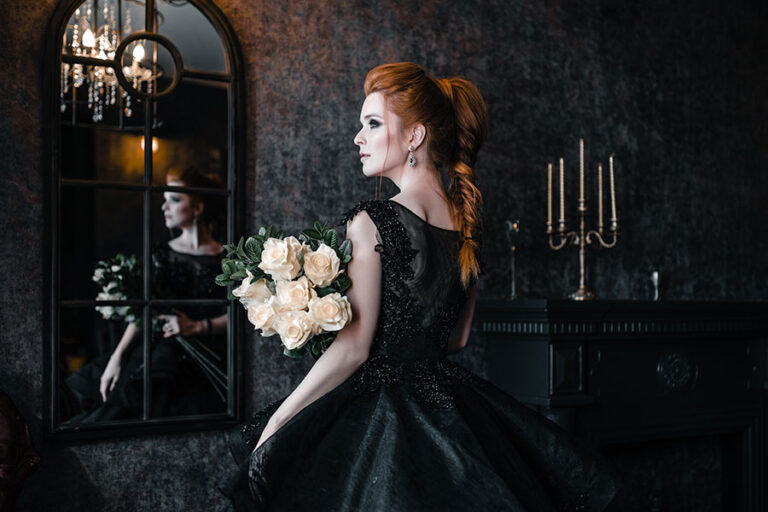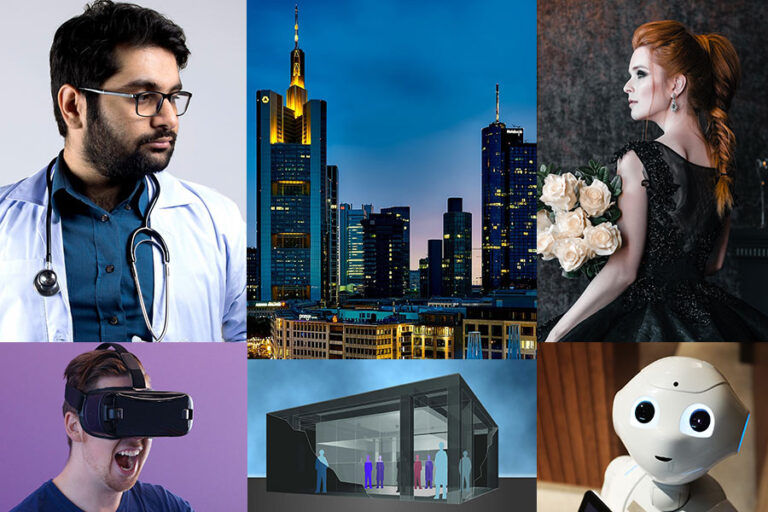
There are many forms of performance where interactive skills are used. Before exploring them, let’s clarify terminology. The word “interactive” and “immersive” sometimes get used interchangeably, but they describe very different things. Immersion is when the story world surrounds you. Interactivity is when participants and performers co-create the story. Both can exist within the same experience to varying degrees. The amount of interactivity and immersion varies by form. With that in mind, let’s consider the many kinds of experiences where interactive skills can be employed.
Interactive theatre
Some interactive shows are performed in traditional theatres with audience members joining the onstage cast to play roles in the story. Interactive theatre comes in many shapes and sizes—from single-scene vignettes, to full-length plays and musicals. (A variety of interactive theatre scripts can be found here.) Interactive theatre offers several benefits: audiences are familiar with going to see shows in theatres, the production infrastructure already exists, and shows can be presented for many people at once. One of the challenges of this form is that spects can feel quite self-conscious in front of an audience.
StoryBox
StoryBox is an interactive performance form that minimizes spects’ self-consciousness. The performance space is a square area surrounded by curtained walls with cameras in each corner. The audience is in a separate room entirely. A spect leaves the audience and goes into the StoryBox to play an improvised story with a team of inter-actors. Stories consist of multiple scenes. Locations are implied through lighting and soundscapes. The audience watches the story over a live video feed. Since the audience is neither seen nor heard, it’s easier for spects to become fully invested in the fiction.
immersive theatre
In immersive theatre, the audience is completely surrounded by the world of the story. As mentioned before, immersive isn’t the same as interactive, but many such shows incorporate degrees of interactive performance. Immersive theatre often involves building out a story world through which the audience can travel. This type of immersive work has been popularized by the commercial success of shows like Sleep No More and Then She Fell. Some immersive shows (also known as environmental) opt to use the locations for what they are.Tony ‘n’ Tina’s Wedding is an example of this, where the story plays out in an actual church and reception hall. Halloween haunts and escape rooms are other immersive forms that sometimes incorporate interactive performance.
SimuLife
SimuLife is a form of interactive performance that takes place in real-world environments over multiple days. The scope is expansive, with the story embedded in public and private locations across an entire city. A few spects play with large casts, invisible crews, and no viewing audience. In public settings, people are often unaware that a performance is even happening, though a scene is playing out right beside them.
Interactive streaming
During the COVID-19 pandemic, this form of socially-distanced interactive performance grew in use. The players and participants come together on a video conferencing call, playing stories through their shared video feeds. This form wrestles with the lack of physical presence, but it increases the ease of distribution and access.
interactive VR
As more people own virtual reality headsets, interactive productions are venturing into the virtual realm. Players and participants from across the globe come together in a shared virtual world. Interactive VR opens up new possibilities for play. Elements such as age, gender, race, and species are far more flexible. Players can inhabit avatars who are nothing like themselves. The physics of virtual worlds offers other interesting opportunities. In virtual reality, it’s possible to fly, walk through walls, and become invisible. Environments and weather systems can be developed that would be impossible to create anywhere else. Like interactive streaming, this form is easily distributable, but with more of a visual wow factor. One example of an interactive VR show is The Under Presents Tempest.
Simulation training
Simulations are used to train professionals in many fields—law enforcement, business, military, education, and hospitality to name a few. This is a way for inter-actors to earn income outside the entertainment industry. Simulation training diminishes the co-creation of story because the focus is on mastery of specific skills. Police officers train in live simulations with performers playing victims and perpetrators. Medical students train with performers playing patients. (More on this in a moment.) In virtual simulations, bring avatars to life through voice acting and digital puppeteering. Examples of this include TeachLive simulations for student teachers and Mursion simulations for business professionals. When doing interactive simulations, ethnic heritage and being multi-lingual can be significant assets.
Standardized patients
This is a form of live simulation that’s used to train medical students. There are many teaching hospitals employ performers to serve as standardized patients. As the name suggests, this work is standardized. Although improvisation is involved, performers need to consistently repeat a standard scenario. You also need the ability to recall and record details of med students’ work in post-performance assessments. Many actors use this as a side gig to make part-time income while continuing to pursue their acting careers. To learn about standardized patients program in your area, check with the Association for Standardized Patient Educators.
Activations
Activations are experiences created to promote a brand or product. Because they’re a form of marketing, activations have budgets to employ inter-actors as characters who engage with guests in the experience. An example of a high-profile activation was the WestWorld experience at South by Southwest, where an entire western town was built and populated with performers. Companies that design activations include Campfire, Giant Spoon, and 42 Entertainment.
Theatre of the Oppressed
Theatre of the Oppressed is a form of interactive performance that was developed by Augusto Boal. This interactive form invites audience members to become the protagonist of scenes about social and political injustice. Possible solutions are explored through the choices that spects make as they play alongside the inter-actors. Theatre of the Oppressed (TO) troupes can be found all over the world. You can learn more about this form in the book Theatre of the Oppressed.
Museum theatre
In this form of interactive performance, inter-actors (also known as interpreters) play characters that engage with guests at cultural institutions. Through activities and conversations with the actor/interpreters, visitors learn about relevant subject matter. This kind of work may involve giving tours, doing demonstrations, or simply living in the environment. When presented as “living history,” actor/interpreters wear period costumes and engage with visitors in conversations that illuminate the culture and politics of the time. A well-established example of this is Colonial Williamsburg. This interactive form can be full-time employment. To learn more about museum theatre, visit the International Museum Theatre Alliance website.
Theme parks
Some theme parks make use of walk-around characters who engage with the guests. There are also attractions like Disney’s Monster’s Inc. Laugh Floor, and Turtle Talk With Crush where animated characters carry on live conversations with audience members. Some parks offer a fully immersive story world populated with interactive characters, like Evermore Park and Star Wars: Galactic Cruiser.
RolePlaying Games
Interactive performance skills come in handy when serving as a Game Master or Dungeon Master for roleplaying games. The game facilitator interacts with the players to keep them engaged in the story. Interactive skills are essential to facilitating good roleplaying in this form.
Experience design
Interactive performance skills are also valuable when designing interactive experiences such as video games, escape rooms, LARPs, guest experiences, etc. Places that offer training in experience design include Odyssey Works, Third Rail Projects, and Punchdrunk Enrichment. The Themed Entertainment Association (TEA) is a professional association for experience designers. TEA sponsors the NextGen initiative, offering students educational resources and helping them find internships, mentorships, and jobs.
This list covers many performance forms in which interactive skills can be applied. New forms are constantly evolving. When creating work yourself, don't feel compelled to mimic a preexisting form. Follow your inspiration. Who knows? It might become a new interactive form to add to the list.
Updated: July 23, 2024






